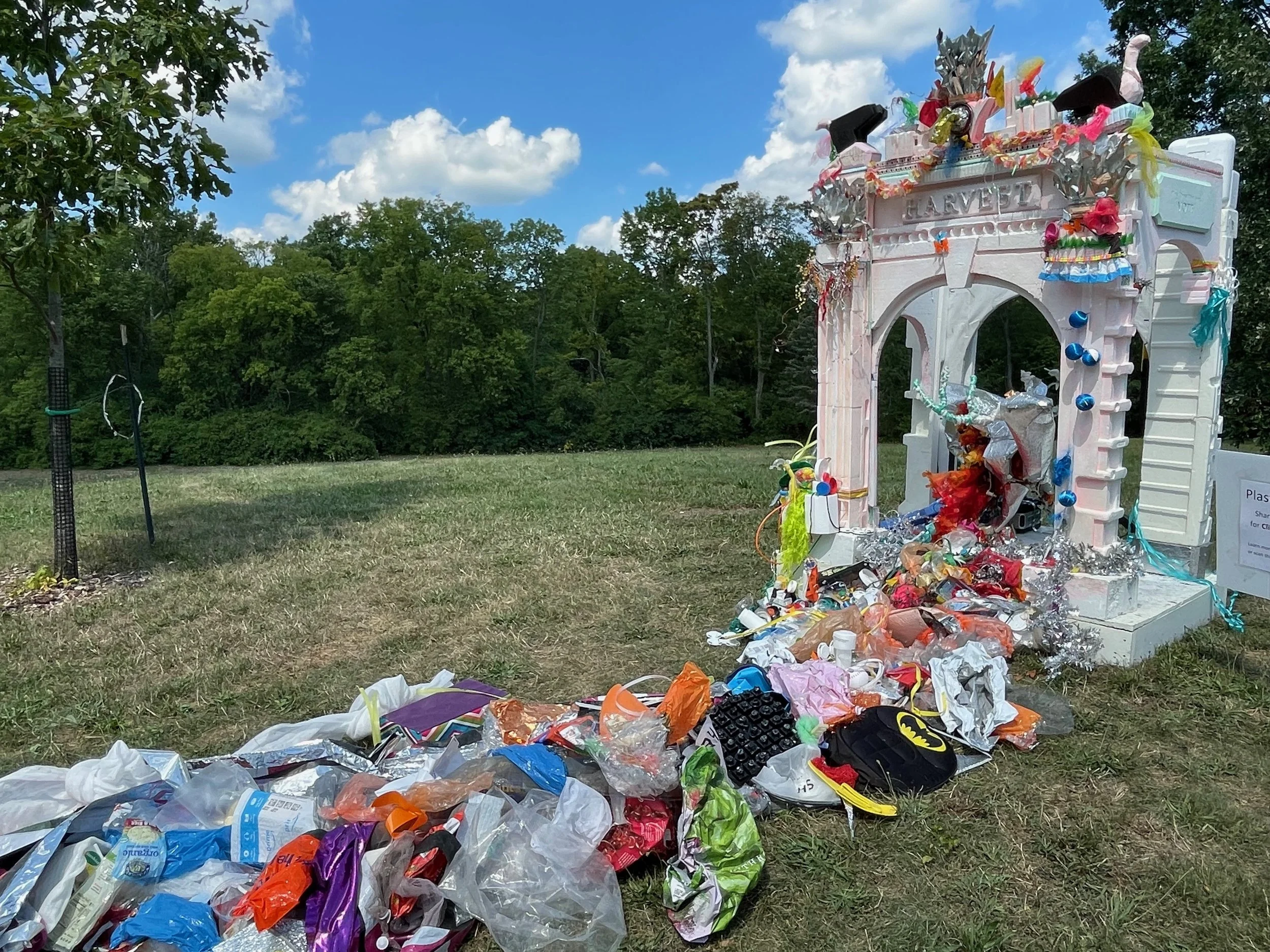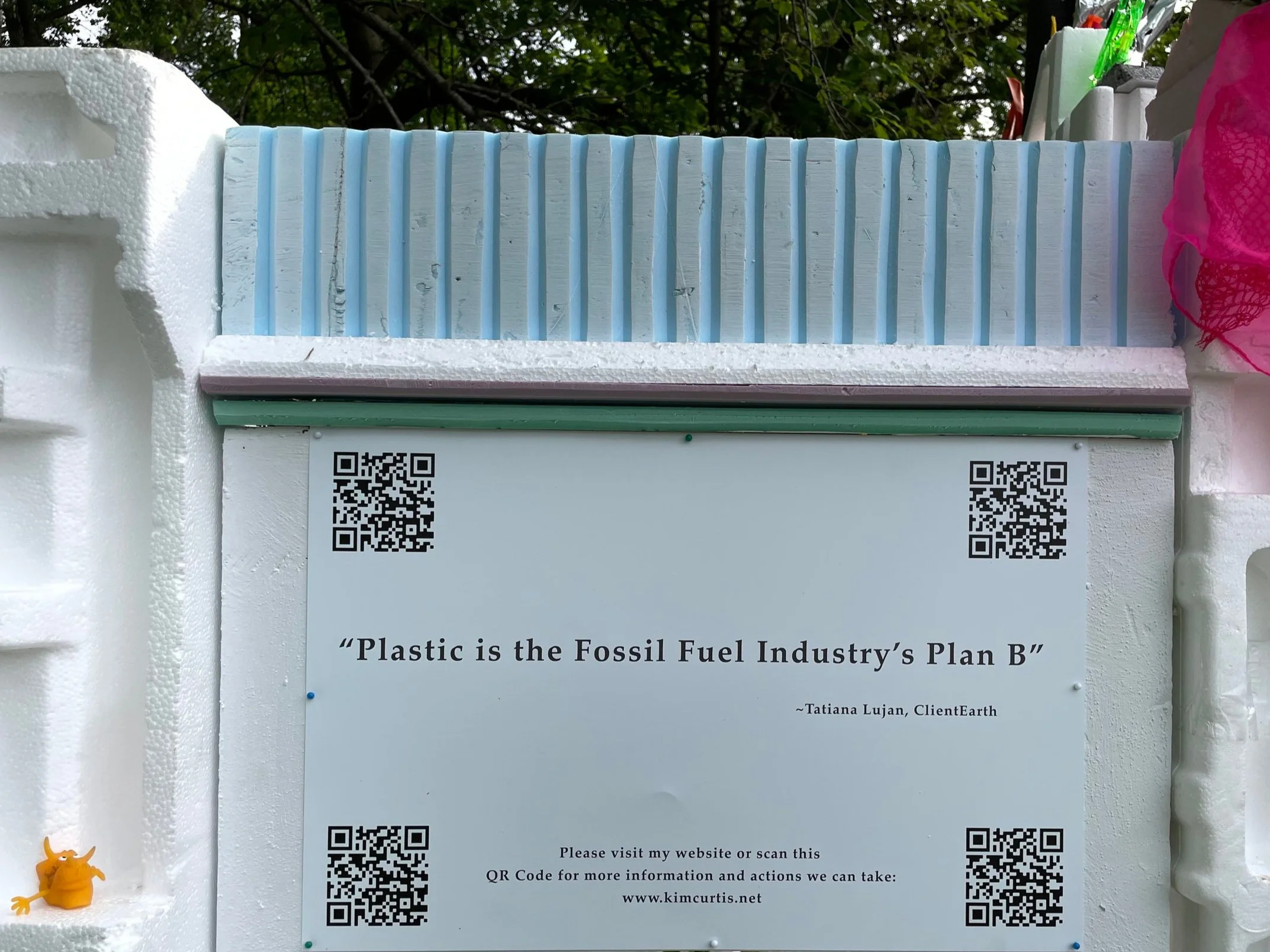HArVEST
A Monument to Plastic Waste
Created from found styrofoam, selectively culled refuse, and a curbed lawn-deer!
Click here to see a video tour of the monument
According to its Greek and Latin etymology, a monument’s purpose is to “advise”, to “remind” and to “warn”. This monument is no different. It addresses a problem we’ve all seen in our landscapes and in the news: the decades-long increase in plastic pollution has now tipped beyond the crisis point. Icebergs and beaches, wildlife and our own human reproductive systems; everything in our closed system is being adversely affected.
If you’re like me, you may have thought that since the problem is internationally recognized, it’s being rectified. That’s where we’re wrong.
“Plastic is the fossil fuel industry’s Plan B” says Tatiana Luján, the lead plastics lawyer at ClientEarth, a London-based environmental law agency. Companies like ExxonMobil, Shell, and Saudi Aramco are aggressively accelerating the production of plastic, in part due to the fact that it’s a free by-product of the hydraulic fracturing process used to extract natural gas. During the “fracking” process which also produces earthquakes, extreme methane burn-off, and drinking-water contamination, a gas called ethane is produced. In the US, we build specifically designed tankers to deliver this gas to “ethane cracking” facilities still being freshly built throughout the US and abroad. These facilities don’t just respond to the demand for more plastic, they generate the demand. Petrochemicals (the category that includes plastic) are expected to drive half of oil demand growth between now and 2050, the International Energy Agency says. The World Economic Forum predicts plastic production will double in the next 20 years. “Europe’s effort to tackle plastic waste is the world’s most ambitious”, says Tim Grabiel, senior lawyer at the Environmental Investigation Agency. Building new production capacity “is completely at odds” with the effort, and with Europe’s ambitious carbon-cutting goals, he said. But the glut of ethane is a source of income for an otherwise flagging natural gas industry which now relies on its by-products to subsidize its costs.
But… we recycle!
Recycling is commendable and we should all continue to dispose of our waste in the most responsible way possible, but we need to be realistic: only nine percent of all the plastic we have ever generated has been recycled. Compare that to the eleven percent that ends up in our waterways. Furthermore, most of our textiles are now made primarily of plastic and because of the dramatic rise in cheap clothing pushed by the Fast Fashion industry, our landfills are overwhelmed with unprecedented numbers of garments that can take up to 200 years to decompose.
Some of us may consider ourselves conscientious consumers but It is crucial to remember that industry -paired with dishonest and seductive advertising- drives our “demand” for products. Since the post-war 40’s, once-frugal Americans have been aggressively messaged to continually increase our consumption. “In 1953,” writes Ginger Strand, “economist and Lehman Brothers banker Paul Mazur fretted that ‘it is absolutely necessary that the products that roll from the assembly lines of mass production be consumed at an equally rapid rate’. Even worse, we have been saddled with the moral responsibility of that urged consumption with ad campaigns such as Keep America Beautiful’s enormously successful crying Indian TV spot. By appealing to consumers to pitch in and “put litter in its place”, the multi-national beverage corporations who comprise “Keep America Beautiful” successfully foisted the responsibility for their produced garbage on each of us while using their extraordinary profits and power to fight conservation legislation.
Architecture
It’s no accident that this monument is made of foam. Since the 1950’s the US has seen a dramatic increase in the use of synthetic foams in construction. Polystyrene foam has a multitude of uses in the building industry, not just for home insulation but for roadway construction! Additionally, it is used for decorative purposes: those Corinthian columns you’ve admired on downtown facades may very well be carved from foam and veneered with stucco.
Some of this substitution may be sparing our riverbeds and mountains from devastating mining and quarrying and the insulation these foams provide cuts down on energy use dramatically. But it’s our our approach to building that is of such great concern. While we preserve and showcase the gorgeous buildings we’ve inherited from centuries past, we hastily erect new structures of dubious aesthetic and structural quality, often funded by developers who have no vested interest in our communities. These projects are primarily profit-driven and prioritize quick return on investment over community enhancement, often maximizing units rather than setbacks and green-space. Champaign-Urbana has seen an astounding surge in high-volume apartment building construction over the last decade, much of which may be superficially attractive but will not age well. Designed to be torn down a few decades later, we’ll find these materials right next to our clothing and disposable sofas in the landfill. Furthermore, what happens when this “demand” wanes? At the end of a pandemic which saw students and faculty retreat to remote instruction, one wonders who will be occupying the countless units recently created. And if they are occupied, what does that mean for our landfills, energy and sewage systems when we’ve added that many individuals onto the grid? What about flood mitigation for the impermeable surfaces expanding across our towns? The climate crisis ensures our area will be increasingly prone to urban flooding, so how is this aggressive expansion in building addressing the protection of our infrastructure and our people?
Actions we can take
Register to vote, read your local paper, and vote in every election. In Illinois, you can click here to register online.
Thank your representatives, including Governor Pritzker for signing into law the Climate and Equitable Jobs Act (CEJA). Let them know you’re watching and willing to help. Support out-of-state candidates and legislators doing good work.
Make your voice heard: Talk and write to your legislators, school boards, newspapers, city council, teachers, where you shop and where you don’t! Join marches, protests and petition drives to fight new oil and gas projects in the US and abroad. These actions are covered by the media and they matter! Contrary to being disruptive, your voice gives those in power the leverage they need to make the changes we want.
Know that you are being marketed to and beware of greenwashing.
Before you buy: consider what its end-of-life will be. How you will dispose of it? Is there a re-usable option instead of a disposable one?
Vote with your dollar: Corporations are huge and so is the difference that they make. Amazon has overcome Walmart as the largest retailer of goods in the world and it occupies even more economic ground with ancillary business in cloud computing, advertising and its third-party marketplace. Even small changes in their approach to packaging, shipping and sales choices have enormous repercussions. Do not support businesses which externalize their waste onto taxpayers. Do support businesses who are genuinely addressing these problems. Talk to cashiers and ask questions-they send the message higher up.
Benefit Corporations or “B Corps” have a financial structure that prioritizes environmental stewardship and social justice alongside profits for their shareholders. Check for the “B” on the back label, buy from them and tell them why!
Energy and climate issues are crucial social justice and anti-racism issues. Pollution, climate distress and labor expoloitation affect the most marginalized communities first and most drastically.
Opt-out of excessive packaging and re-use what comes your way. Buy in bulk, bring your own bags and containers. Avoid purchasing ziplock bags etc. in favor of re-use. Look for more responsible packaging options-like deodorant in cardboard canisters and toothpaste in aluminum tubes (both now at Target!) Avoid SHIPPING which relies on heavy packaging. Did you know you can recycle clean styrofoam (not peanuts) at the Dart Cup Factory just down the street?
Support local and global organizations working on our behalf and read their newsletters:
Prairie Rivers Network www.prairierivers.org, is the Illinois affiliate of the Nat’l Wildlife Federation and works specifically on local/regional issues such as coal ash removal, agricultural runoff and soil regeneration.
Faith in Place www.faithinplace.org Chicago-based environmental and social justice action group connecting all groups of faith to these important issues and resources including heavy lifting on getting CEJA passed.
University of Illinois Institute of Sustainability, Energy and Environment, take a class! Join the mailing list, get involved!
350.org “is building a future that's just, prosperous, equitable and safe from the effects of the climate crisis”. www.350.org
Beyond Plastics: https://www.beyondplastics.org/: online courses available
Client Earth: international law practice working to hold governments and corporations accountable:Client Earth
National Resources Defense Council (NRDC)
Sources
National Geographic Magazine https://www.nationalgeographic.com/environment/article/europe-plastics-industry-about-to-boom-us-fracking-driving-it
Grist magazine https://grist.org/climate/big-oils-plan-b-is-already-in-the-pipeline-more-plastic/
Orion Magazine (which cites UIUC’s own Advertising Council Archives) https://orionmagazine.org/article/the-crying-indian/
The Insider https://www.businessinsider.com/fast-fashion-environmental-impact-pollution-emissions-waste-water-2019-10
The New York Times https://www.nytimes.com/2019/09/03/books/review/how-fast-fashion-is-destroying-the-planet.html
475 Building Supply https://foursevenfive.com/blog/is-foam-evil-a-new-paradigm-of-foam-less-is-more/
ForConstructionPros.com https://www.forconstructionpros.com/concrete/article/21199420/the-role-of-geofoam-in-the-evolution-of-the-modern-construction-industry
Wikipedia: “Monument” The origin of the word "monument" comes from the Greek mnemosynon and the Latin moneo, monere, which means 'to remind', 'to advise' or 'to warn',[3] suggesting a monument allows us to see the past thus helping us visualize what is to come in the future.[4]



